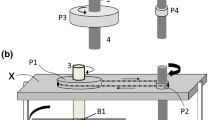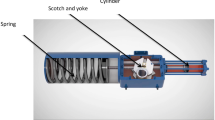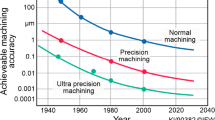Abstract
This research analyzes the source of the power consumption in an optical disk drive (ODD) of a laptop computer. It shows that approximately 70 % of electrical input power is dissipated through the windage loss in the ODD. The windage loss is calculated by simulating the air flow around the rotating disk, and the simulated windage loss is verified by comparing with the measured one. It investigates the windage loss according to the variation of the upper and lower gaps between the rotating disk and case, and the optimal upper and lower gaps are determined by using the response surface methodology to reduce the windage loss. Finally, it shows experimentally that the proposed optimal model reduces total power consumption by 6.5 %.














Similar content being viewed by others
References
Bertotti G, Boglietti A, Chiampi M, Chiarabaglio D, Fiorillo F, Lazzari M (1991) An improved estimation of iron losses in rotating electrical machines. IEEE Trans Magn 27(6):5007–5009
Box GEP, Draper NR (1987) Empirical model building and response surfaces. Wiley, New York
Cheng CC, Wu FT, Ho KL (2009) Reduction of flow-induced vibration and noise of an optical disk drive. J Sound Vib 320(1–2):43–59
Cho SO, Lee SY, Rhim YC (2005) Aerodynamically induced power loss in hard disk drives. Microsys Technol Sens Actuators Syst Integr 11(8–10):741–746
Imai S, Tokuyama M, Yamaguchi Y (1999) Reduction of disk flutter by decreasing disk-to-shroud spacing. IEEE Trans Magn 35(5):2301–2303
Jang GH, Lee SH, Kim HW (2006) Finite element analysis of the coupled journal and thrust bearing in a computer hard disk drive. J Tribol 128(2):335–340
Myers RH, Montgomery DC (1995) Response surface methodology: process and product optimization using designed experiments. Wiley, New York
Sato I, Otani K, Mizukami M, Oguchi S, Hoshiya K, Shimokura KI (1990) Characteristics of heat transfer in small disk enclosures at high rotation speeds. IEEE Trans Compon Hybrids Manuf Technol 13(4):1006–1011
Shimizu H, Tokuyama M, Imai S, Nakamura S, Sakai K (2001) Study of aerodynamic characteristic in hard disk drives by numerical simulation. IEEE Trans Magn 37(2):831–836
Author information
Authors and Affiliations
Corresponding author
Rights and permissions
About this article
Cite this article
Jung, Y.H., Jang, G.H. Reduction of windage loss of an optical disk drive utilizing air-flow analysis and response surface methodology. Microsyst Technol 18, 1445–1453 (2012). https://doi.org/10.1007/s00542-012-1570-5
Received:
Accepted:
Published:
Issue Date:
DOI: https://doi.org/10.1007/s00542-012-1570-5




